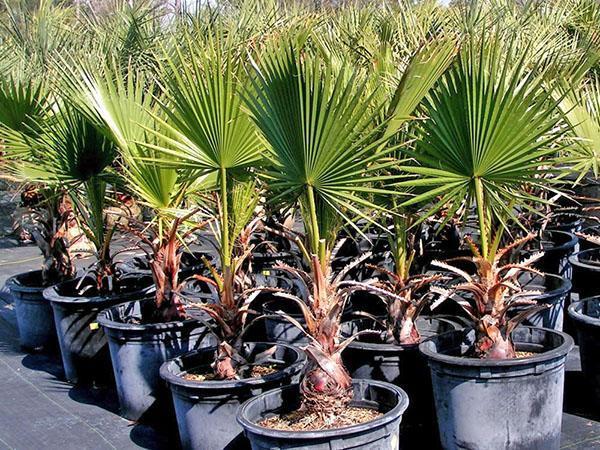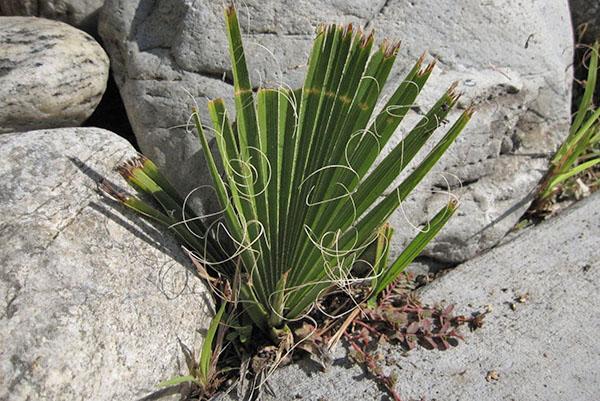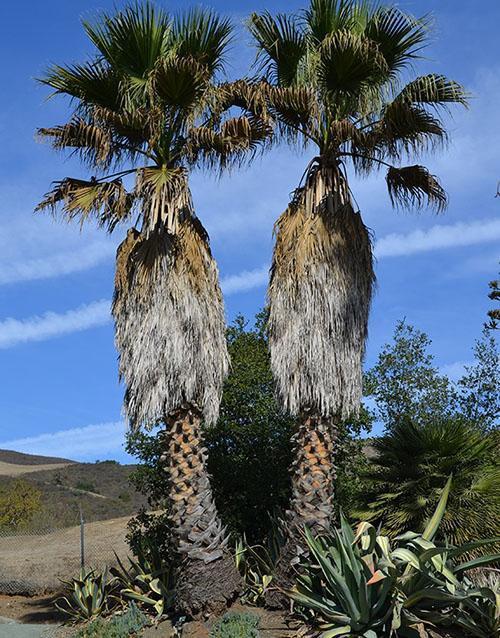Interesting facts about Washington
 Washingtonia is the most famous palm used for outdoor gardening and indoor cultivation. Before you get a large plant, you need to find out everything about Washington: interesting facts, features of reproduction, transplantation and maintenance of a culture that has fallen into homes from the southwestern United States and from Mexico.
Washingtonia is the most famous palm used for outdoor gardening and indoor cultivation. Before you get a large plant, you need to find out everything about Washington: interesting facts, features of reproduction, transplantation and maintenance of a culture that has fallen into homes from the southwestern United States and from Mexico.
The small genus, named after the first president of the United States, unites only two species that are similar in appearance. Washingtonia filamentary or Washingtonia filifera is a native of California, and Washingtonia robust or Washingtonia robusta is an indigenous inhabitant of the more humid and warmer Mexican plateaus.
Washingtonia: all about the popular palm tree

At a young age, Washingtonia filamentous seedlings are easily recognizable by the whitish pile formed on the leaves. But on adult palms this feature is often lost and even specialists sometimes find it difficult to distinguish what kind of tree is in front of them.
Speaking of interesting facts about Washington, one cannot fail to mention that the California variety has become a living symbol of the American South.
The indigenous people of the regions of North and Central America have long used fresh fruits for food, and flour is prepared from dried seeds. Some Native American tribes harvested leaves to make roofs, baskets and even shoes resembling modern sandals. Dense palm wood is an excellent building material and raw material for the production of tableware and other household utensils.
Today, plants that tolerate winds, heat, light frosts and droughts adorn the streets, they can be found in suburban areas and in the wild.
 However, soon the usual slender silhouettes may disappear from the cityscape. The point is in the brownish-gray skirts constantly forming under the crown. City services complain that dry leaves are a source of fire danger, as well as a place where insects willingly settle, attracted by the fruits of birds and even snakes. Not only do climbers and special equipment are needed to remove dead foliage on 30-meter trees, in Florida, where thunderstorms are frequent, the towering crowns of Washington increasingly play the role of lightning rods and flash like candles.
However, soon the usual slender silhouettes may disappear from the cityscape. The point is in the brownish-gray skirts constantly forming under the crown. City services complain that dry leaves are a source of fire danger, as well as a place where insects willingly settle, attracted by the fruits of birds and even snakes. Not only do climbers and special equipment are needed to remove dead foliage on 30-meter trees, in Florida, where thunderstorms are frequent, the towering crowns of Washington increasingly play the role of lightning rods and flash like candles.
Palm washingtonia at home
 The dislike of palm trees by the city authorities in the southern states of the USA does not diminish the value of these plants as bright, very responsive to care and very unpretentious indoor plants.
The dislike of palm trees by the city authorities in the southern states of the USA does not diminish the value of these plants as bright, very responsive to care and very unpretentious indoor plants.
In a pot culture, washingtonia is more often grown. She:
- somewhat smaller than its Mexican relative;
- differs in rather rapid growth;
- tolerates drought better and even survives frosts down to -10 degrees;
- resistance to common pests and diseases of Washington.
 The formation of a strong skirt in Washington is observed in young trees. As soon as the palm tree has the opportunity to freely shed dry leaves, it gets rid of them.
The formation of a strong skirt in Washington is observed in young trees. As soon as the palm tree has the opportunity to freely shed dry leaves, it gets rid of them.
Washinia threading for barrel cleaning requires outside help.
Among the interesting facts about Washington, it is necessary to mention the presence of a hybrid species of this plant. Washingtonia filibasta, according to the plan of the breeders, should have better cold resistance than robusta and the same excellent drought resistance as the filamentous variety.
Features and timing of Washington transplant

Washingtonia is threadingI am extremely unpretentious. It can grow on a strongly alkaline substrate and even on sand. But to feel good in a limited pot, the plant still needs nutrients. Vashintonia transplant in the first years of life is carried out by transferring to a larger pot.In this case, you should not choose too large a container.
At home or in a greenhouse, palms are necessarily transplanted. It is best to do this in the spring, at the beginning of the active growing season, when it will be easiest for the tree to repair the inevitable damage and quickly grow.
But how do you handle a large specimen? The usual transplantation of a perennial palm is impossible, therefore, it is limited to removing 5–10 cm of the top layer of the soil and replacing it with a fresh, looser and fertile substrate. During transplantation, Washingtonia cannot be buried; this is monitored both during complete transshipment and when replacing part of the soil.
In spring and summer, complex fertilizers of prolonged action are used for feeding palm trees.
Reproduction of washingtonia
 This genus of fast-growing palms does not form root shoots or offspring, therefore, young plants can only be obtained with seeds that look like roasted coffee beans.
This genus of fast-growing palms does not form root shoots or offspring, therefore, young plants can only be obtained with seeds that look like roasted coffee beans.
In nature, birds and winds contribute to the reproduction of Washingtonia. Fresh seeds falling to the ground begin to sprout in a couple of days, and soon thin green "blades of grass" appear under the crown of an adult plant. This is exactly what the sprouts of a palm tree look like, which in adulthood strikes with large fan-shaped leaves.
The leaves do not become feathery immediately, but when the plant is already getting stronger. This is a peculiar feature and another interesting fact about Washington. So the plant has adapted to defend itself from livestock feeding on arid pastures and trampling down some of the green plants.
Seeds, which a grower can buy in a store, begin to germinate only after 30-60 days. Therefore, they are pre-soaked in warm water for a day, and then sown in a mixture of leafy earth, perlite and washed sand.